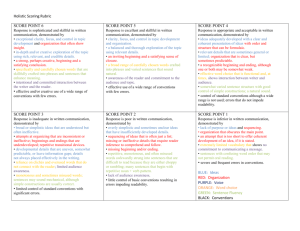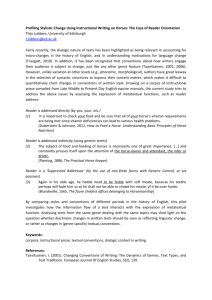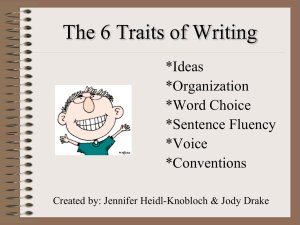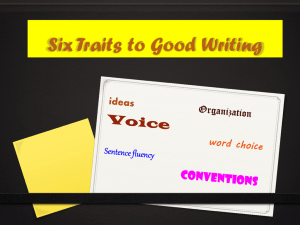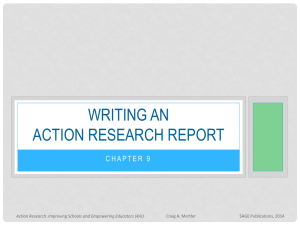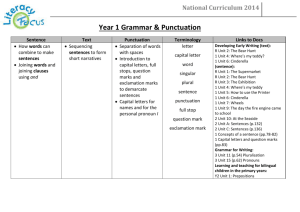MS Word
advertisement
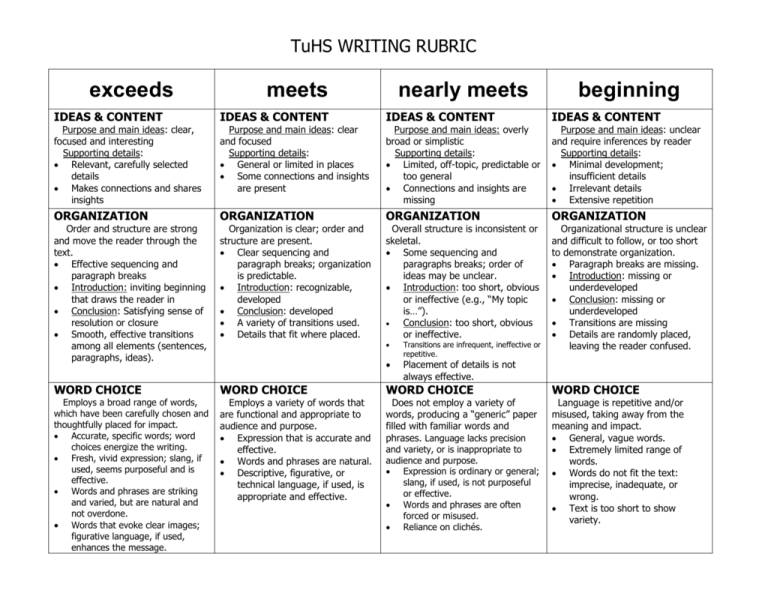
TuHS WRITING RUBRIC exceeds meets nearly meets beginning IDEAS & CONTENT IDEAS & CONTENT IDEAS & CONTENT IDEAS & CONTENT Purpose and main ideas: clear, focused and interesting Supporting details: Relevant, carefully selected details Makes connections and shares insights Purpose and main ideas: clear and focused Supporting details: General or limited in places Some connections and insights are present Purpose and main ideas: overly broad or simplistic Supporting details: Limited, off-topic, predictable or too general Connections and insights are missing Purpose and main ideas: unclear and require inferences by reader Supporting details: Minimal development; insufficient details Irrelevant details Extensive repetition ORGANIZATION ORGANIZATION ORGANIZATION ORGANIZATION Order and structure are strong and move the reader through the text. Effective sequencing and paragraph breaks Introduction: inviting beginning that draws the reader in Conclusion: Satisfying sense of resolution or closure Smooth, effective transitions among all elements (sentences, paragraphs, ideas). Organization is clear; order and structure are present. Clear sequencing and paragraph breaks; organization is predictable. Introduction: recognizable, developed Conclusion: developed A variety of transitions used. Details that fit where placed. Overall structure is inconsistent or skeletal. Some sequencing and paragraphs breaks; order of ideas may be unclear. Introduction: too short, obvious or ineffective (e.g., “My topic is…”). Conclusion: too short, obvious or ineffective. Organizational structure is unclear and difficult to follow, or too short to demonstrate organization. Paragraph breaks are missing. Introduction: missing or underdeveloped Conclusion: missing or underdeveloped Transitions are missing Details are randomly placed, leaving the reader confused. WORD CHOICE WORD CHOICE WORD CHOICE WORD CHOICE Employs a broad range of words, which have been carefully chosen and thoughtfully placed for impact. Accurate, specific words; word choices energize the writing. Fresh, vivid expression; slang, if used, seems purposeful and is effective. Words and phrases are striking and varied, but are natural and not overdone. Words that evoke clear images; figurative language, if used, enhances the message. Employs a variety of words that are functional and appropriate to audience and purpose. Expression that is accurate and effective. Words and phrases are natural. Descriptive, figurative, or technical language, if used, is appropriate and effective. Does not employ a variety of words, producing a “generic” paper filled with familiar words and phrases. Language lacks precision and variety, or is inappropriate to audience and purpose. Expression is ordinary or general; slang, if used, is not purposeful or effective. Words and phrases are often forced or misused. Reliance on clichés. Language is repetitive and/or misused, taking away from the meaning and impact. General, vague words. Extremely limited range of words. Words do not fit the text: imprecise, inadequate, or wrong. Text is too short to show variety. Transitions are infrequent, ineffective or repetitive. Placement of details is not always effective. TuHS WRITING RUBRIC exceeds meets nearly meets beginning SENTENCE FLUENCY SENTENCE FLUENCY SENTENCE FLUENCY SENTENCE FLUENCY Writing has an easy flow and rhythm. Sentences are carefully crafted, with strong and varied structure. Sentence beginnings: sentences begin in different ways, adding interest. Sentence lengths: a variety of lengths that add interest. Sentence patterns: a variety of complex patterns that add interest. Stylistic control: dialogue, if used, sounds natural. Writing is easy to read aloud; sounds natural; variety of sentence beginnings, lengths and patterns. Sentence beginnings: most sentences begin in different ways. Some repetition detracts from overall impact. Sentence lengths: some sentences are shorter; some are longer. Some repetition detracts from overall impact. Sentence patterns: somewhat varied. Some control over more complex sentences. Dialogue: if used, most sounds natural. Some parts are easy to read aloud; occasional awkward constructions force the reader to slow down. Sentence beginnings: many sentences begin the same way. Sentence lengths: many sentences are the same length. Sentence patterns: many are the same. Little control over more complex sentences. Dialogue: does not sound natural. Writing tends to either be choppy, rambling or incomplete. Awkward constructions force the reader to slow down or reread. Sentence beginnings: begin the same way. Sentence lengths: same lengths-either short and choppy or long and rambling. Sentence patterns: repeated over and over. (e.g., subjectverb or subject-verb-object). Sentence structure that obscures meaning. Confusing word order. Text is too short to demonstrate variety and control. CONVENTIONS CONVENTIONS CONVENTIONS CONVENTIONS Strong control of conventions; uses conventions effectively to enhance readability. Errors are few and minor. Correct grammar and usage that contribute to clarity and style. Skill in using a wide range of conventions. Little need for editing. Control of conventions. Minor errors do not impede readability. Control over conventions used, although a wide range is not demonstrated. Correct end-of-sentence punctuation; internal punctuation is sometimes incorrect. Moderate need for editing. Limited control of conventions. Errors begin to impede readability. Some control over basic conventions; text is too simple or too short to reveal proficiency. End-of-sentence punctuation is usually correct; however, internal punctuation contains frequent errors. Spelling errors that distract the reader. Capitalization errors. Significant need for editing. TuHS English Department 2013 (Revised from ODE Official Scoring Guide 2010-2011) Little control of conventions. Frequent errors impede readability. Many end-of-sentence punctuation errors; internal punctuation contains frequent errors. Spelling errors frequently distract the reader; misspelling of common words often occurs. Capitalization that is inconsistent or often incorrect. Extensive need for editing.
